The game opens with you, bounty hunter Samus Aran, arriving on Planet Zebes to complete your mission to destroy the secret base of the Space Pirates and their pet metroids. But that backstory is all you know, and booting up the game finds you standing on a screen with a couple enemies already walking around, pondering whether or not to kill you, while you have to figure out what in the world you should be doing and where you should be going.
 So rather than show you screenshots of the game's action, which admittedly looks cool on its own, I decided I would show you the painful reality of this game as best I could. A major premise of the game is the collection of powerups - Samus' body armor was designed by a birdlike alien race known as the Chozo, who had once inhabited Planet Zebes, and left behind statues with suit modifications on them in case they ever returned. So Samus can steadily gain these throughout the game, becoming more powerful.
So rather than show you screenshots of the game's action, which admittedly looks cool on its own, I decided I would show you the painful reality of this game as best I could. A major premise of the game is the collection of powerups - Samus' body armor was designed by a birdlike alien race known as the Chozo, who had once inhabited Planet Zebes, and left behind statues with suit modifications on them in case they ever returned. So Samus can steadily gain these throughout the game, becoming more powerful.Which naturally makes the screen above completely ironic, because somehow - I don't even recall how I found myself there - I got stuck behind this statue whose sole purpose is to give me a powerup. You can't jump back over it because you can't fit between its head and the ceiling. The only way past is to have bombs, which you lay in "morph ball" mode. So if it was unclear, that orange ball is me in this position. The red thing under me is the bomb, which, if I'm lucky, will eventually propel me back over the statue. If I didn't have bombs? Reset the whole game. YEAH.
And then the bosses. Metroid only has three boss fights, and in a game this expansive, that means you'd better make them count. But they all suck. Below is Ridley, whose species is classified as "Space Dragon," as ridiculous as that sounds. He's also the chief of security for the Space Pirates, which is probably why you were able to infiltrate their top secret base in the first place. He fights you by jumping up and down and tossing little purple balls that slow the framerate of the game so severely it's nigh impossible to do anything.
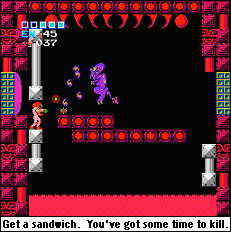 In fact, when you enter through that door on the right, you will likely drop to the platform directly under it to try to shoot him. It's the most reasonable place to go, right? But then you realize you can't shoot through those purple ball things he's firing, so you have to get up on his platform. But you can't jump up there. You know why? Because the door closes and juts out above your head. Seriously! You will drop into that acid stuff because the freaking door was designed to screw you over. If you DO manage to get on the platform, the purple crap usually launches you back deeper into the acid, which constantly drains your life. I honestly have no clue how I got to the place I'm standing in the picture. What I do know, however, is that if you are on that point with the most powerful gun in the game, Ridley can't hit you at all, and you can shoot him freely.
In fact, when you enter through that door on the right, you will likely drop to the platform directly under it to try to shoot him. It's the most reasonable place to go, right? But then you realize you can't shoot through those purple ball things he's firing, so you have to get up on his platform. But you can't jump up there. You know why? Because the door closes and juts out above your head. Seriously! You will drop into that acid stuff because the freaking door was designed to screw you over. If you DO manage to get on the platform, the purple crap usually launches you back deeper into the acid, which constantly drains your life. I honestly have no clue how I got to the place I'm standing in the picture. What I do know, however, is that if you are on that point with the most powerful gun in the game, Ridley can't hit you at all, and you can shoot him freely.Which sounds like a great deal, except he just...won't...die. The best option at that point is to weigh down the shoot button on your controller somehow, leave the room, and do something productive for a while. Come back half an hour later or so. He might be dead by then, maybe. It's a fight that doesn't test your coordination and gaming skill...only your patience.
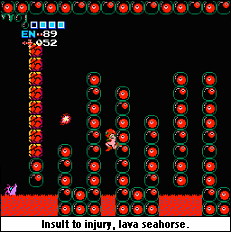 And what about this crap? You get knocked back when an enemy hits you, which is fairly standard. But why make this spot that you can get knocked into with absolutely no hope of escape? I tried everything. Jumping out, shooting out, bombing out, even trying to submerge myself in the lava and go under the pillars, but none of them worked. Instead you just get to sit there and watch all your health slowly evaporate until the game over screen. How is that in any way fun?
And what about this crap? You get knocked back when an enemy hits you, which is fairly standard. But why make this spot that you can get knocked into with absolutely no hope of escape? I tried everything. Jumping out, shooting out, bombing out, even trying to submerge myself in the lava and go under the pillars, but none of them worked. Instead you just get to sit there and watch all your health slowly evaporate until the game over screen. How is that in any way fun?And speaking of health, that's easily my biggest issue with this game. You start the game with 30 health, or "energy." I thought that was an odd number, but hey, maybe that's where you max out. But no, you quickly realize after killing some enemies and collecting health that you max out at 99. Why would Samus start a mission at less than full strength? It makes no sense. And whenever you die, you continue from the entry point of the region you died in, which is fine in itself; I can accept a penalty for dying. But you start at 30 energy again! Throughout the game you collect energy tanks, each of which increases your capacity by 100 energy points. Eventually you can have 700 energy. But if you die, say on a boss, you are sent back to that starting area at 30 life. Just 30. And of course at that point enemies are doing about 20 damage to you per hit, so you end up in this mind-numbing cycle of dying and restarting. The only way to avoid it is to sit there for an hour killing respawning enemies to refill your health. And the more you can have, the longer time you spend. It's penalizing you for getting upgrades! So you can understand how depressed was on the screen above, with all that health gone forever.
 Then there are the metroids themselves, which you honestly by this point begin to believe don't actually exist at all. They're freaky jellyfish things that latch onto your head and suck life away almost as quickly as this game sucks your soul. You have to lay bombs inside them to get them off for a second, but one isn't enough! Imagine someone put a bomb inside your throat. Would you stop whatever you were doing? Of course you would, because you're not ridiculous. This game is. And what's worse, if you've been putting in the effort and time, by this point of the game you have the most powerful weapon upgrade. But guess what? Metroids are immune to it. Fooled you, huh! You have to go all the way back to a totally different area of the game and downgrade your weapon to even have a chance of surviving the encounter.
Then there are the metroids themselves, which you honestly by this point begin to believe don't actually exist at all. They're freaky jellyfish things that latch onto your head and suck life away almost as quickly as this game sucks your soul. You have to lay bombs inside them to get them off for a second, but one isn't enough! Imagine someone put a bomb inside your throat. Would you stop whatever you were doing? Of course you would, because you're not ridiculous. This game is. And what's worse, if you've been putting in the effort and time, by this point of the game you have the most powerful weapon upgrade. But guess what? Metroids are immune to it. Fooled you, huh! You have to go all the way back to a totally different area of the game and downgrade your weapon to even have a chance of surviving the encounter.Not that finding the weapons is easy in the first place. The emphasis in Metroid is on exploration, which is great. I love exploring, and I don't even mind being plopped down with no explanation of where to go, as long as the game is compelling enough to warrant it. Metroid obviously does not fit that bill. So instead, you wander around aimlessly, getting killed repeatedly thanks to your 30 health, around screens that look practically identical to one another. In fact, the game does reuse exact screens - enemies and all - from time to time, which can be incredibly confusing. If you survive to find any powerups, you'll have to keep wandering to see if you can get anywhere new. All it would take to make this acceptable would be a map. Let me see a map when I hit pause. Why isn't there one in here? Oh, because you put that map in Nintendo Power magazine. I honestly believe that this game was created specifically to sell subscriptions to Nintendo's pet magazine, because who was going to figure this out on their own? I bet Nintendo Power even called it one of the best games of all time. Oh wait, they did.
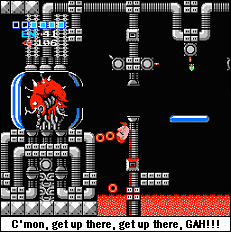 Now we've all probably seen shots of the final showdown with "Mother Brain," the leader of the Space Pirate forces (none of whom are even present at any point during the game). It looks simple, and possibly fun, standing on that pillar shooting missiles into the brain until the whole place explodes and you win. What I am showing you instead is the horrible truth behind that fight. The fact that there is so much crap shooting you that you will inevitably fall into the lava here. You'd like to jump back up to where you were, but that's not possible. It's too high. Instead, you have to jump up to the platform where Mother Brain is. But if you touch the glass, you get shot back down into the lava. If you don't touch the glass, something will likely hit you, so you fall back into the lava. The entire fight revolves around trying to shoot a stationary target while escaping a lava pit right next to it, and it's hard as hell. Who green-lighted this thing? And naturally, missiles are the only thing that hurts it. If you run out of missiles during the fight (or even before it, because you have to destroy 5 walls with them on the way...that constantly regenerate), guess what? You're boned. Can't win. Go die. Come back with 30 health. See how you do then.
Now we've all probably seen shots of the final showdown with "Mother Brain," the leader of the Space Pirate forces (none of whom are even present at any point during the game). It looks simple, and possibly fun, standing on that pillar shooting missiles into the brain until the whole place explodes and you win. What I am showing you instead is the horrible truth behind that fight. The fact that there is so much crap shooting you that you will inevitably fall into the lava here. You'd like to jump back up to where you were, but that's not possible. It's too high. Instead, you have to jump up to the platform where Mother Brain is. But if you touch the glass, you get shot back down into the lava. If you don't touch the glass, something will likely hit you, so you fall back into the lava. The entire fight revolves around trying to shoot a stationary target while escaping a lava pit right next to it, and it's hard as hell. Who green-lighted this thing? And naturally, missiles are the only thing that hurts it. If you run out of missiles during the fight (or even before it, because you have to destroy 5 walls with them on the way...that constantly regenerate), guess what? You're boned. Can't win. Go die. Come back with 30 health. See how you do then. Then, when you finally do manage to beat the thing, the whole base is set to explode and a countdown timer appears for you to escape. The escape route consists of tiny little platforms that you have to jump to. But jumping is far from precise in Metroid, so here you are trying to methodically jump from tiny platform to tiny platform, often falling, while a timer counts down to your death. If you die, guess where you start? Yeah, with 30 health before the boss. Fight it again. I don't think it's a coincidence that the happiest-sounding music of the entire game plays during this escape sequence. The game is genuinely elated that you're going to die and have to redo everything. And if you DO get out of there, you get a screen saying, in broken English, that you succeeded and there's peace. Sike! Just kidding, there's not really peace, but you can pray for it if it'll make you feel better. What a load of horse manure.
Then, when you finally do manage to beat the thing, the whole base is set to explode and a countdown timer appears for you to escape. The escape route consists of tiny little platforms that you have to jump to. But jumping is far from precise in Metroid, so here you are trying to methodically jump from tiny platform to tiny platform, often falling, while a timer counts down to your death. If you die, guess where you start? Yeah, with 30 health before the boss. Fight it again. I don't think it's a coincidence that the happiest-sounding music of the entire game plays during this escape sequence. The game is genuinely elated that you're going to die and have to redo everything. And if you DO get out of there, you get a screen saying, in broken English, that you succeeded and there's peace. Sike! Just kidding, there's not really peace, but you can pray for it if it'll make you feel better. What a load of horse manure.The only reason Metroid has a score this high is that when you get fully powered up, which is like Chinese water torture to accomplish, the game is admittedly a little enjoyable. Because then you're not dying when random freaks of nature so much as look in your general direction, and things don't take 90 shots to kill. If you're one of the people crying blasphemy and thinking this game was the cat's meow or the bee's knees or somesuch, go back and check it out now. It might not be as hideous the second time, because you at least already know where to go. But rereleases of the game were generally called mediocre at best. Because they didn't change anything from the original. Because the original game, my friends, sucks the big one.
Bottom Line: 5/20
 I'm going to kick this review off by ruining the ending for you. You ready? You ready?! Glance to the right. BAM! Ending spoiled. And that's the good ending. There's actually a worse one if you don't collect all the chaos emeralds during the game, which I'll talk about later down the page. This ending was too awesome for the cartridge label or title screen, and can only be earned by beating the game like a consummate pro. That's the kind of dude Sonic is, and you'd better get used to it. There are even multiple paths through every single level in the game. Make your own rules. Sonic does.
I'm going to kick this review off by ruining the ending for you. You ready? You ready?! Glance to the right. BAM! Ending spoiled. And that's the good ending. There's actually a worse one if you don't collect all the chaos emeralds during the game, which I'll talk about later down the page. This ending was too awesome for the cartridge label or title screen, and can only be earned by beating the game like a consummate pro. That's the kind of dude Sonic is, and you'd better get used to it. There are even multiple paths through every single level in the game. Make your own rules. Sonic does. The game is a side- scrolling platformer, but is designed on most levels to be played quickly. By that I mean Sonic can just run, at blazing speeds, through each level without stopping so long as he's not getting hit or running into walls. Need to run upside down a bit to accomplish this, or up a wall? No problem. Just run fast enough. The earlier stages especially allow this. And the powerups on each level consist of different items sitting around inside television screens, which can be accessed by destroying the television set itself. Sonic the Hedgehog rewards vandals. But I guess "stage" and "level" aren't the right words. Sonic has "zones," which are each divided into three "acts." So classy.
The game is a side- scrolling platformer, but is designed on most levels to be played quickly. By that I mean Sonic can just run, at blazing speeds, through each level without stopping so long as he's not getting hit or running into walls. Need to run upside down a bit to accomplish this, or up a wall? No problem. Just run fast enough. The earlier stages especially allow this. And the powerups on each level consist of different items sitting around inside television screens, which can be accessed by destroying the television set itself. Sonic the Hedgehog rewards vandals. But I guess "stage" and "level" aren't the right words. Sonic has "zones," which are each divided into three "acts." So classy. The variety of each zone's design will be immediately apparent. The backgrounds are different, of course, but so are the enemies, obstacles, and style of gameplay. Some zones are covered in springs, which launch Sonic high into the air. Some have lightning orbs pulsing electricity out. Some have giant pools of lava. It really helps the game retain its fun factor throughout the entire experience.
The variety of each zone's design will be immediately apparent. The backgrounds are different, of course, but so are the enemies, obstacles, and style of gameplay. Some zones are covered in springs, which launch Sonic high into the air. Some have lightning orbs pulsing electricity out. Some have giant pools of lava. It really helps the game retain its fun factor throughout the entire experience. To that end Sega is diligent about trying to include ample opportunities for you to breathe. You can jump out of the water, of course, but most of the time you'll be looking for bubbles. Stand atop the bubble area long enough, and eventually a large enough bubble will emerge that Sonic is able to "breathe" it in and replenish his oxygen supply. Which brings me to a larger question: Why make him need to breathe at all? I suspect the rationale was that it would lend an extra degree of realism to the game, or perhaps extra challenge and urgency. But with so many bubble areas all over, the urgency isn't there. And why would you seek realism in a game with a blue hedgehog breathing bubbles and running almost as fast as the speed of sound?
To that end Sega is diligent about trying to include ample opportunities for you to breathe. You can jump out of the water, of course, but most of the time you'll be looking for bubbles. Stand atop the bubble area long enough, and eventually a large enough bubble will emerge that Sonic is able to "breathe" it in and replenish his oxygen supply. Which brings me to a larger question: Why make him need to breathe at all? I suspect the rationale was that it would lend an extra degree of realism to the game, or perhaps extra challenge and urgency. But with so many bubble areas all over, the urgency isn't there. And why would you seek realism in a game with a blue hedgehog breathing bubbles and running almost as fast as the speed of sound? If you are in possession of at least 50 rings by the end of any given act (except boss acts and the final couple zones), a gigantic ring floats above the level's end. Jumping into it accesses a constantly rotating bonus stage in which Sonic curls up into a ball and tries not to vomit all over himself, while simultaneously attempting to acquire a gem called a chaos emerald. Having all the emeralds grants obscene power, so Sonic has to get to them before Dr. Robotnik can. The bonus stages are pretty strange, but I have to admit they're enjoyable once you get the hang of them. I just hope you aren't someone who gets motion sickness easily.
If you are in possession of at least 50 rings by the end of any given act (except boss acts and the final couple zones), a gigantic ring floats above the level's end. Jumping into it accesses a constantly rotating bonus stage in which Sonic curls up into a ball and tries not to vomit all over himself, while simultaneously attempting to acquire a gem called a chaos emerald. Having all the emeralds grants obscene power, so Sonic has to get to them before Dr. Robotnik can. The bonus stages are pretty strange, but I have to admit they're enjoyable once you get the hang of them. I just hope you aren't someone who gets motion sickness easily. Each zone culminates in a battle with Dr. Robotnik, who always has some new device and/or attachment to his hovercraft to foible your attempts to stop him. It's cleverly simple - you attack him the same way every time (by jumping into him), but because you're avoiding different weapons from his machines, the timing and tempo change up. Each boss battle is actually a good time in itself. The good doctor even punks you at the end when you think you've reached him in his own factory. He flips a switch that drops the floor out from under your feet and sends you into...another water level. Touché, sir! It definitely makes his final defeat a good deal more satisfying.
Each zone culminates in a battle with Dr. Robotnik, who always has some new device and/or attachment to his hovercraft to foible your attempts to stop him. It's cleverly simple - you attack him the same way every time (by jumping into him), but because you're avoiding different weapons from his machines, the timing and tempo change up. Each boss battle is actually a good time in itself. The good doctor even punks you at the end when you think you've reached him in his own factory. He flips a switch that drops the floor out from under your feet and sends you into...another water level. Touché, sir! It definitely makes his final defeat a good deal more satisfying. Mario had the name, the selling power, and was the unquestioned king of video games at the time. The first two Super Mario Bros. games were already out in America, and Japan had The Lost Levels and even Super Mario Bros. 3 to play. The guy's name was as good as gold. By putting his mug on a Game Boy launch title, it wouldn't matter if the game sucked or the whole console sucked - both would sell. It's a prudent marketing strategy, really. And while it's not exactly fair to say Super Mario Land sucks, it would certainly be a stretch to call it good.
Mario had the name, the selling power, and was the unquestioned king of video games at the time. The first two Super Mario Bros. games were already out in America, and Japan had The Lost Levels and even Super Mario Bros. 3 to play. The guy's name was as good as gold. By putting his mug on a Game Boy launch title, it wouldn't matter if the game sucked or the whole console sucked - both would sell. It's a prudent marketing strategy, really. And while it's not exactly fair to say Super Mario Land sucks, it would certainly be a stretch to call it good.
 If you've ever taken trigonometry or calculus, and the screen at left seems eerily familiar, it might be because someone in your class was playing it on his or her graphing calculator. That's right, a TI-83 could in essence run Super Mario Land. Clearly part of that is the fact that, like any console, it takes several games to figure out how to get the most out of it. But I feel like they had to have been able to do better than this, right? And what's with that enemy? There's a piranha plant which is well and good, but what is up with that prancing colonist? The worst part is that he doesn't even die when you jump on him. It just stuns him, and he keeps following you. Creeper.
If you've ever taken trigonometry or calculus, and the screen at left seems eerily familiar, it might be because someone in your class was playing it on his or her graphing calculator. That's right, a TI-83 could in essence run Super Mario Land. Clearly part of that is the fact that, like any console, it takes several games to figure out how to get the most out of it. But I feel like they had to have been able to do better than this, right? And what's with that enemy? There's a piranha plant which is well and good, but what is up with that prancing colonist? The worst part is that he doesn't even die when you jump on him. It just stuns him, and he keeps following you. Creeper.
 The game's story is pretty incomprehensible. Mario is out to save Princess Daisy, who doesn't seem to have any relation whatsoever to Peach, from her captors. But her captor isn't Bowser; I'm not really sure it's anyone. The enemies all seem totally unrelated, as do the worlds. And half the boss fights are just total clones of the Super Mario Bros. Bowser fights, including the "bridge release" switch or whatever it's supposed to be. So why not just make it Bowser? Why this Sphinx thing? What's the Egypt motif actually accomplishing here?
The game's story is pretty incomprehensible. Mario is out to save Princess Daisy, who doesn't seem to have any relation whatsoever to Peach, from her captors. But her captor isn't Bowser; I'm not really sure it's anyone. The enemies all seem totally unrelated, as do the worlds. And half the boss fights are just total clones of the Super Mario Bros. Bowser fights, including the "bridge release" switch or whatever it's supposed to be. So why not just make it Bowser? Why this Sphinx thing? What's the Egypt motif actually accomplishing here?
 There's also a whole world dedicated to aliens for some reason, and another one on Easter Island. They even replace the flying Koopa Troopas with - I kid you not - winged Easter Island heads. Why? Speaking of Koopas, when you jump on one in this game, they detonate. Yeah, like a bomb. I don't know why either. I have no answers for you.
The game is mercifully brief, at least. Whereas Super Mario Bros. had 8 worlds with 4 levels each (32 levels total), Super Mario Land has 4 worlds with 3 levels each (12 levels total). Throughout most of them there plays a catchy little ditty that you may have heard
There's also a whole world dedicated to aliens for some reason, and another one on Easter Island. They even replace the flying Koopa Troopas with - I kid you not - winged Easter Island heads. Why? Speaking of Koopas, when you jump on one in this game, they detonate. Yeah, like a bomb. I don't know why either. I have no answers for you.
The game is mercifully brief, at least. Whereas Super Mario Bros. had 8 worlds with 4 levels each (32 levels total), Super Mario Land has 4 worlds with 3 levels each (12 levels total). Throughout most of them there plays a catchy little ditty that you may have heard  The game does commendably try to shake things up a bit by including two vehicle levels. The first of these uses a submersible pod that fires torpedoes at everything in your way, and the second is an airplane that works in exactly the same way. These levels are interesting and more fun to play than the standard ones, and have special bosses that you fight within the vehicle. This game almost works better as a sidescrolling vehicle shooter than it does as a Mario game, which is pretty sad when you think about it.
Some of the gameplay mechanics are unusual as well. For instance, often times if you run or jump straight into an enemy (rather than on top of it), the enemy will still take a hit and die, though you'll take damage. It's not really one or the other anymore. Bullet Bill launchers can now emerge from pipes, and the bullets themselves cannot be jumped on or killed. Mario's fireballs now also act like boomerangs, and can collect coins for him. One change I liked: if you're jumping when you get a super mushroom (the ones that make you big), your momentum doesn't stop. In Super Mario Bros., getting a powerup in midair was a virtual death sentence, which wasn't too fair.
The game does commendably try to shake things up a bit by including two vehicle levels. The first of these uses a submersible pod that fires torpedoes at everything in your way, and the second is an airplane that works in exactly the same way. These levels are interesting and more fun to play than the standard ones, and have special bosses that you fight within the vehicle. This game almost works better as a sidescrolling vehicle shooter than it does as a Mario game, which is pretty sad when you think about it.
Some of the gameplay mechanics are unusual as well. For instance, often times if you run or jump straight into an enemy (rather than on top of it), the enemy will still take a hit and die, though you'll take damage. It's not really one or the other anymore. Bullet Bill launchers can now emerge from pipes, and the bullets themselves cannot be jumped on or killed. Mario's fireballs now also act like boomerangs, and can collect coins for him. One change I liked: if you're jumping when you get a super mushroom (the ones that make you big), your momentum doesn't stop. In Super Mario Bros., getting a powerup in midair was a virtual death sentence, which wasn't too fair.
 At least the princess this time around actually appears to have been worth saving. Not only does she thank you unconditionally, but she also runs straight over to you and gives you a little heart affection. Taking notes here, Peach? The hilarious thing is that, as Nintendo would later reveal, Princess Daisy is actually the girlfriend of Luigi. Mario's younger brother. It's unclear whether that happened after Mario had had enough of her, or whether he was just taking advantage of his brother's absence. But this is arguably the first instance of Luigi-prejudice...a theme we will see slowly develop over time throughout Mario's game library.
But back on point. Super Mario Land is a quick game, which is wholly a good thing. It looks ugly, plays ugly, and doesn't feel too Mario-like, which is obviously unacceptable for a flagship Mario game to launch a console. But it succeeds a bit in the vehicle stages, the music is too catchy to ignore, and you're never too frustrated as you play, which can be a rarity amongst Mario games. Overall, it's pretty much a completely average game.
Bottom Line: 10/20
At least the princess this time around actually appears to have been worth saving. Not only does she thank you unconditionally, but she also runs straight over to you and gives you a little heart affection. Taking notes here, Peach? The hilarious thing is that, as Nintendo would later reveal, Princess Daisy is actually the girlfriend of Luigi. Mario's younger brother. It's unclear whether that happened after Mario had had enough of her, or whether he was just taking advantage of his brother's absence. But this is arguably the first instance of Luigi-prejudice...a theme we will see slowly develop over time throughout Mario's game library.
But back on point. Super Mario Land is a quick game, which is wholly a good thing. It looks ugly, plays ugly, and doesn't feel too Mario-like, which is obviously unacceptable for a flagship Mario game to launch a console. But it succeeds a bit in the vehicle stages, the music is too catchy to ignore, and you're never too frustrated as you play, which can be a rarity amongst Mario games. Overall, it's pretty much a completely average game.
Bottom Line: 10/20
 The game cartridge contained an internal battery that allowed saving. While we take that concept for granted now, the ability to save (much less to have multiple save files on one cartridge) was a pretty nifty feature at the time. And with a game as challenging as this one, it was definitely a blessing.
The game cartridge contained an internal battery that allowed saving. While we take that concept for granted now, the ability to save (much less to have multiple save files on one cartridge) was a pretty nifty feature at the time. And with a game as challenging as this one, it was definitely a blessing.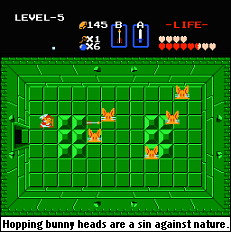 Thankfully, you'll soon find that the similarities with Mario stop at the basic plot outline. The Legend of Zelda plays from an overhead perspective, and from the start puts you in the middle of this giant kingdom with nothing to your name but a tiny shield and no indication of where to go or what to do. But Hyrule can be unforgiving, and it's dangerous to go alone, so you should first find some sort of weapon.
Thankfully, you'll soon find that the similarities with Mario stop at the basic plot outline. The Legend of Zelda plays from an overhead perspective, and from the start puts you in the middle of this giant kingdom with nothing to your name but a tiny shield and no indication of where to go or what to do. But Hyrule can be unforgiving, and it's dangerous to go alone, so you should first find some sort of weapon. But over and above the combat with monsters, the emphasis in the game is placed on puzzles. The old man at right is a regular sight in the game, giving you cryptic clues as to what to do next or where to go to find helpful items. Of course, he's also completely senile, which might cause you to attack him in frustration. But that's really a bad idea. The flames at his sides will start shooting crap at you and you'll get destroyed pretty quick. The Legend of Zelda subtly is telling children to respect their elders, and you have to give it some credit for that.
But over and above the combat with monsters, the emphasis in the game is placed on puzzles. The old man at right is a regular sight in the game, giving you cryptic clues as to what to do next or where to go to find helpful items. Of course, he's also completely senile, which might cause you to attack him in frustration. But that's really a bad idea. The flames at his sides will start shooting crap at you and you'll get destroyed pretty quick. The Legend of Zelda subtly is telling children to respect their elders, and you have to give it some credit for that. The flip side is that this gives you a huge sense of reward when you solve a problem. I'm not sure I've ever felt better about myself for merely setting foot in the entrance door of a dungeon as I have in this game, because sometimes finding the dungeon takes longer than completing it! And a great feature of the game is the inventory, which will steadily expand as you play. Every dungeon has at least one inventory item you can add to your possession. So while you start with just a shield (and a dinky wooden sword when you find it), eventually you're throwing boomerangs, shooting silver arrows, riding rafts, exploding bombs, and...handing out...giant hocks of ham.....ok, so it doesn't all make sense, but it's still pretty entertaining.
The flip side is that this gives you a huge sense of reward when you solve a problem. I'm not sure I've ever felt better about myself for merely setting foot in the entrance door of a dungeon as I have in this game, because sometimes finding the dungeon takes longer than completing it! And a great feature of the game is the inventory, which will steadily expand as you play. Every dungeon has at least one inventory item you can add to your possession. So while you start with just a shield (and a dinky wooden sword when you find it), eventually you're throwing boomerangs, shooting silver arrows, riding rafts, exploding bombs, and...handing out...giant hocks of ham.....ok, so it doesn't all make sense, but it's still pretty entertaining. And then there's the enormous graveyard, which comprises six or seven screens. Usually there's a ghost floating around each screen, which you can't kill with any standard weaponry, because it's a ghost. So you're content to leave them all alone, but then some hag tantalizes you with the knowledge that there is someone hiding in the graveyard who will give you something. So you walk around trying to move the gravestones to find hidden passages, as any sane, greedy grave robber might do. And the ghosts get pissed. Every time you touch a tombstone a new ghost appears and it's not long before you are having the poop haunted out of you by legions of the undead. And then you flee to the adjacent screen where there are a bunch of warrior statues camped out, and accidentally bump one, and oh god, now it's coming to life and trying to kill me with its spear, get it off get it off!
And then there's the enormous graveyard, which comprises six or seven screens. Usually there's a ghost floating around each screen, which you can't kill with any standard weaponry, because it's a ghost. So you're content to leave them all alone, but then some hag tantalizes you with the knowledge that there is someone hiding in the graveyard who will give you something. So you walk around trying to move the gravestones to find hidden passages, as any sane, greedy grave robber might do. And the ghosts get pissed. Every time you touch a tombstone a new ghost appears and it's not long before you are having the poop haunted out of you by legions of the undead. And then you flee to the adjacent screen where there are a bunch of warrior statues camped out, and accidentally bump one, and oh god, now it's coming to life and trying to kill me with its spear, get it off get it off! If you manage to survive the dangers of the world and figure out how to even GET to Ganon's hideout, you're rewarded with the hugest and most difficult dungeon yet. It's even shaped like a skull, which we all know is the universal sign for "You're about to get owned." When you finally find Ganon, who is basically an overgrown swine thing, you have to fight him while he's invisible. That's fair, right?
If you manage to survive the dangers of the world and figure out how to even GET to Ganon's hideout, you're rewarded with the hugest and most difficult dungeon yet. It's even shaped like a skull, which we all know is the universal sign for "You're about to get owned." When you finally find Ganon, who is basically an overgrown swine thing, you have to fight him while he's invisible. That's fair, right?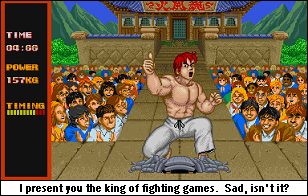 With that said, I'm going to shock a lot of you here: Street Fighter is one of the worst games I can remember playing. It's better than Urban Champion, for sure, but Street Fighter is just a nightmare to play. I want to blame the 1987 technology, but that's not fair when you look at the vast array of good games coming out in that time period. That schmuck you see above is Ryu. Yes, the Ryu. That's taken from one of the game's bonus levels, in which you have to chop through a cinder block, or kick wooden boards for extra points. But the guy is clearly a tool, as are the nameless sycophants cheering him on.
With that said, I'm going to shock a lot of you here: Street Fighter is one of the worst games I can remember playing. It's better than Urban Champion, for sure, but Street Fighter is just a nightmare to play. I want to blame the 1987 technology, but that's not fair when you look at the vast array of good games coming out in that time period. That schmuck you see above is Ryu. Yes, the Ryu. That's taken from one of the game's bonus levels, in which you have to chop through a cinder block, or kick wooden boards for extra points. But the guy is clearly a tool, as are the nameless sycophants cheering him on.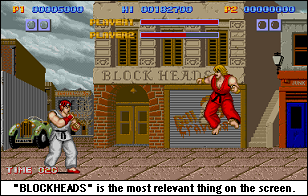 Now let's talk about the multiplayer component of the game before we go any further. That portion of the game is significant because it involves the only point at which you can control anyone other than Ryu. While Player 1 is still stuck with him, Player 2 gets control of a guy named Ken, who is blonde and clothed in red, but otherwise identical in every single way to Ryu. Same moves, same style, same control, everything. And Ken exists only in the multiplayer portion; he appears nowhere in the single player game. The reason for this is unexplained.
Now let's talk about the multiplayer component of the game before we go any further. That portion of the game is significant because it involves the only point at which you can control anyone other than Ryu. While Player 1 is still stuck with him, Player 2 gets control of a guy named Ken, who is blonde and clothed in red, but otherwise identical in every single way to Ryu. Same moves, same style, same control, everything. And Ken exists only in the multiplayer portion; he appears nowhere in the single player game. The reason for this is unexplained. The other fighters are usually just amalgamations of stereotypes condensed into single beings. You get a Chinese farmer type dude, the British punk (keeping in mind this was on the heels of the British punk movement), Japan has a ninja...you get the idea. The other Brit is this dude, named Eagle, who looks like he belongs less in Street Fighter and more in a rousing game of Clue.
The other fighters are usually just amalgamations of stereotypes condensed into single beings. You get a Chinese farmer type dude, the British punk (keeping in mind this was on the heels of the British punk movement), Japan has a ninja...you get the idea. The other Brit is this dude, named Eagle, who looks like he belongs less in Street Fighter and more in a rousing game of Clue. The worst part of the game though is the fighting. Which is obviously pretty unacceptable when working within the format of a fighting game. There are six attack buttons, though many times it is difficult if not impossible to distinguish any difference in their functions. Every move, and I do mean every move, including jumping, happens on a severe delay. You'll be mortified the first time you press the punch button and see the arm fly out a full second later.
The worst part of the game though is the fighting. Which is obviously pretty unacceptable when working within the format of a fighting game. There are six attack buttons, though many times it is difficult if not impossible to distinguish any difference in their functions. Every move, and I do mean every move, including jumping, happens on a severe delay. You'll be mortified the first time you press the punch button and see the arm fly out a full second later. Not that it matters too much anyway, because the fights themselves are absurd. You can button mash the first full six or seven matches and never take a hit. The AI is just terrible, and it's obvious that the computer can't even handle the lag of this game. And if you do somehow manage to land a special move, you'll take away half the opponent's life, and that's not an exaggeration.
Not that it matters too much anyway, because the fights themselves are absurd. You can button mash the first full six or seven matches and never take a hit. The AI is just terrible, and it's obvious that the computer can't even handle the lag of this game. And if you do somehow manage to land a special move, you'll take away half the opponent's life, and that's not an exaggeration.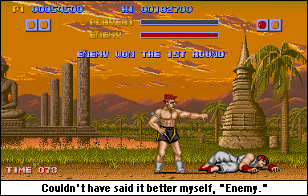 Well, I persevered so you wouldn't have to. The last two fights take place in Thailand, where both fighters (Adon and Sagat) fight in Muay Thai. Surprised? No? Because you're used to the stereotypes by now. And when you finally win, a battered Sagat tells you that you're now "king of the hill." Only he tells you through that horrible voice modulation crap. Then the credits roll, and they're all in broken English. They even misspell some of the names of their own programming and design team. I know, because I looked it up. Again, so you wouldn't have to.
Well, I persevered so you wouldn't have to. The last two fights take place in Thailand, where both fighters (Adon and Sagat) fight in Muay Thai. Surprised? No? Because you're used to the stereotypes by now. And when you finally win, a battered Sagat tells you that you're now "king of the hill." Only he tells you through that horrible voice modulation crap. Then the credits roll, and they're all in broken English. They even misspell some of the names of their own programming and design team. I know, because I looked it up. Again, so you wouldn't have to. The answer? Make the people you are shooting Nazi soldiers, and the player an American Jewish prisoner of war. Who could complain? The result was Wolfenstein 3-D, a game banned in Germany not because they were offended by its bloody content, but because they were embarrassed by the concept of a Nazi prison complete with swastika banners and portraits of Hitler. Fantastic.
The answer? Make the people you are shooting Nazi soldiers, and the player an American Jewish prisoner of war. Who could complain? The result was Wolfenstein 3-D, a game banned in Germany not because they were offended by its bloody content, but because they were embarrassed by the concept of a Nazi prison complete with swastika banners and portraits of Hitler. Fantastic. You'll find quickly that the Nazis are a sloppy bunch of people, who tend to leave things strewn about in any old place. Baskets of dog treats, tv dinners, first aid kits, pistol clips, hoards of treasure...you name it. There seems to be zero accountability within the Nazi ranks for cleanliness concerns. Conveniently, the food and ammunition happen to help you out on your quest to escape. So much for German efficiency.
You'll find quickly that the Nazis are a sloppy bunch of people, who tend to leave things strewn about in any old place. Baskets of dog treats, tv dinners, first aid kits, pistol clips, hoards of treasure...you name it. There seems to be zero accountability within the Nazi ranks for cleanliness concerns. Conveniently, the food and ammunition happen to help you out on your quest to escape. So much for German efficiency. The game has four weapons - the aforementioned knife and pistol, machine guns that SS officers carry, and a powerful chaingun. Each bigger gun is a direct upgrade to the one before it, but the knife actually retains some usefulness throughout; if you incessantly stab at an enemy, they will be too busy wincing to shoot at you. And then they'll die. It's barbarous, yes, but guess what? They're Nazis. See how well that works?
The game has four weapons - the aforementioned knife and pistol, machine guns that SS officers carry, and a powerful chaingun. Each bigger gun is a direct upgrade to the one before it, but the knife actually retains some usefulness throughout; if you incessantly stab at an enemy, they will be too busy wincing to shoot at you. And then they'll die. It's barbarous, yes, but guess what? They're Nazis. See how well that works? The evil genius behind the plague is this dude, Doctor von Badguy or something. He's holed himself up in another big fortress where he infects people with his zombie plague and manufactures enormous throwing syringes filled with poisonous doom. But mainly infects people with his zombie plague.
The evil genius behind the plague is this dude, Doctor von Badguy or something. He's holed himself up in another big fortress where he infects people with his zombie plague and manufactures enormous throwing syringes filled with poisonous doom. But mainly infects people with his zombie plague.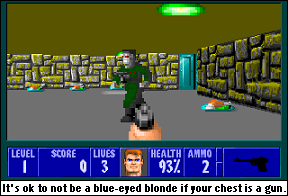 So you naturally have to fight through a bunch of these Nazombies on your way to kill the schmuck. They're actually pretty frightening. All the living enemies make some sort of noise when they become aware of your presence. I still wake up in a cold sweat some nights thinking I heard someone shout "SPIEN!" before shooting me. Even the dogs bark, at least. But these guys are silent killers. Killers with guns. Coming out of their chests. Which are fired by raising their arms in alternation. With quite a bit of speed and enthusiasm. It's not pleasant, and so Doctor von Badguy must perish.
So you naturally have to fight through a bunch of these Nazombies on your way to kill the schmuck. They're actually pretty frightening. All the living enemies make some sort of noise when they become aware of your presence. I still wake up in a cold sweat some nights thinking I heard someone shout "SPIEN!" before shooting me. Even the dogs bark, at least. But these guys are silent killers. Killers with guns. Coming out of their chests. Which are fired by raising their arms in alternation. With quite a bit of speed and enthusiasm. It's not pleasant, and so Doctor von Badguy must perish. It's therefore a bit of a relief when you finally get to the large room containing the madman himself. Although it's pretty unhelpful of him to be riding around in a large suit of battle armor. And even when the armor is destroyed, he jumps out with two chainguns that were evidently in his hands the entire time. How were you operating that suit again?
It's therefore a bit of a relief when you finally get to the large room containing the madman himself. Although it's pretty unhelpful of him to be riding around in a large suit of battle armor. And even when the armor is destroyed, he jumps out with two chainguns that were evidently in his hands the entire time. How were you operating that suit again? The first thing you see after the title screen is the stage select, and it definitely makes you a little wary. I'm all for keeping it simple, but this singular screen tells you that the game will revolve around defeating six robots, each of which being just a different gimmick. Thanks to the
The first thing you see after the title screen is the stage select, and it definitely makes you a little wary. I'm all for keeping it simple, but this singular screen tells you that the game will revolve around defeating six robots, each of which being just a different gimmick. Thanks to the  This creates a gameplay environment characterized by jumping and shooting your arm cannon, called the Mega Buster. Each stage is littered with smaller robots designed by Dr. Wily to aid in his conquest, as well as various hazards. Among the hazards, two will instantly kill you. The first is the ubiquitous bottomless pit. The second, of course, is spikes. Now I'm not sure how someone with the intelligence and capability to create an android from scratch fails to solve the problem of "exploding upon any contact with a stationary pointed object," but there you have it. It makes me wonder - if Dr. Wily was so sincere in not wanting to be stopped, why not surround his entire fortress with miles of spikes? He'd be invincible. But I digress.
This creates a gameplay environment characterized by jumping and shooting your arm cannon, called the Mega Buster. Each stage is littered with smaller robots designed by Dr. Wily to aid in his conquest, as well as various hazards. Among the hazards, two will instantly kill you. The first is the ubiquitous bottomless pit. The second, of course, is spikes. Now I'm not sure how someone with the intelligence and capability to create an android from scratch fails to solve the problem of "exploding upon any contact with a stationary pointed object," but there you have it. It makes me wonder - if Dr. Wily was so sincere in not wanting to be stopped, why not surround his entire fortress with miles of spikes? He'd be invincible. But I digress.
 The stages each have a distinct feel to them, which is a nice touch. Although some of this plays on the obvious, such as having lightning shooting around on Elecman's stage, many times simple changes of scenery can go a long way to prevent the game from feeling tedious or monotonous. The game really climaxes in the visual department with what you see above. There's not really any good reason for anything that is going on in that picture to be happening. It all just sort of happens simultaneously and without explanation. And it's great.
The stages each have a distinct feel to them, which is a nice touch. Although some of this plays on the obvious, such as having lightning shooting around on Elecman's stage, many times simple changes of scenery can go a long way to prevent the game from feeling tedious or monotonous. The game really climaxes in the visual department with what you see above. There's not really any good reason for anything that is going on in that picture to be happening. It all just sort of happens simultaneously and without explanation. And it's great.

 And then of course, when you finally get to the heretofore unseen Dr. Wily, you realize that this entire time you've actually been trying to murder Albert Einstein. The guy was apparently the greatest scientific genius of the twenty-first century as well as the twentieth. Greedy snob. He also rides around in a flying saucer. So if this game taught me anything, it is that Albert Einstein was responsible not only for nuclear weaponry, but also for UFO sightings, conspiracy theories, and the eventual robot takeover of Earth. What an ass. And when you finally beat him, he just sits there crying like a little girl. And you let him go. Stupid. I guess we'll see you in
And then of course, when you finally get to the heretofore unseen Dr. Wily, you realize that this entire time you've actually been trying to murder Albert Einstein. The guy was apparently the greatest scientific genius of the twenty-first century as well as the twentieth. Greedy snob. He also rides around in a flying saucer. So if this game taught me anything, it is that Albert Einstein was responsible not only for nuclear weaponry, but also for UFO sightings, conspiracy theories, and the eventual robot takeover of Earth. What an ass. And when you finally beat him, he just sits there crying like a little girl. And you let him go. Stupid. I guess we'll see you in  Then Mega Man starts running across the screen while the credits roll, as the background scenery slowly changes from a beautiful sunset to downtown Metropolis, and he sort of spontaneously sheds all his armor to star in random NES beat-em-up games. Huh?
Then Mega Man starts running across the screen while the credits roll, as the background scenery slowly changes from a beautiful sunset to downtown Metropolis, and he sort of spontaneously sheds all his armor to star in random NES beat-em-up games. Huh?
 Moonwalker is based on the movie of the same name, with the loose plot being that the villain, Mr. Big (played in the film by Joe Pesci), has been kidnapping children. Therefore, Michael Jackson has two major tasks to complete in this game.
Moonwalker is based on the movie of the same name, with the loose plot being that the villain, Mr. Big (played in the film by Joe Pesci), has been kidnapping children. Therefore, Michael Jackson has two major tasks to complete in this game. The Dance button, on the other hand, requires dance power to use. You start with one dance power per life, and can occasionally get bonus dance powers. Using Dance sends a spotlight down on Michael, changes the music, and causes every enemy (even dogs) on screen to dance with him in tandem. After all, when Michael Jackson starts dancing, who can resist joining in with perfect synchronization? At the conclusion of the dance, everything on screen spontaneously explodes. It's like looking in the face of God - one cannot dance with Michael Jackson and expect to survive the experience.
The Dance button, on the other hand, requires dance power to use. You start with one dance power per life, and can occasionally get bonus dance powers. Using Dance sends a spotlight down on Michael, changes the music, and causes every enemy (even dogs) on screen to dance with him in tandem. After all, when Michael Jackson starts dancing, who can resist joining in with perfect synchronization? At the conclusion of the dance, everything on screen spontaneously explodes. It's like looking in the face of God - one cannot dance with Michael Jackson and expect to survive the experience.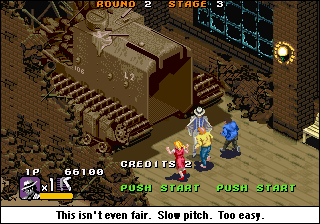 After defeating the boss, the children you saved during the level excitedly run toward Michael to celebrate their liberation. And then Michael celebrates with them, as you see above....well, I'm sure it's totally innocent. He's just dancing and they want hugs. He saved their lives, after all. The next level will then begin with a quick comic book style intro, the usual Jackson yelp, and a dance move.
After defeating the boss, the children you saved during the level excitedly run toward Michael to celebrate their liberation. And then Michael celebrates with them, as you see above....well, I'm sure it's totally innocent. He's just dancing and they want hugs. He saved their lives, after all. The next level will then begin with a quick comic book style intro, the usual Jackson yelp, and a dance move.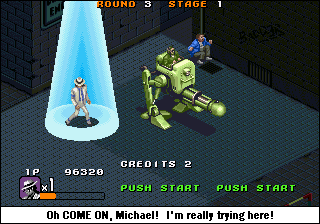 And you know, zombies are probably some of the most "normal" enemies in this game. As you play you will be confronted by: Mobsters, Laser-wielding shock troopers, shirtless crack addicts with knives, dog handlers with stun batons, armor plated dogs, robotic statues, laser turrets, zombies, guys rolling around in tires, miniature steamrollers with lasers, renegade vacuum cleaners, buzzsaw launchers, flamethrowing sewer lids, drone hovercraft, tear gas grenades, and finally, small and giant versions of frog-hopping piston machines. These last are some of the most difficult to defeat; partly because they take a lot of damage, and partly because you really don't want to touch them.
And you know, zombies are probably some of the most "normal" enemies in this game. As you play you will be confronted by: Mobsters, Laser-wielding shock troopers, shirtless crack addicts with knives, dog handlers with stun batons, armor plated dogs, robotic statues, laser turrets, zombies, guys rolling around in tires, miniature steamrollers with lasers, renegade vacuum cleaners, buzzsaw launchers, flamethrowing sewer lids, drone hovercraft, tear gas grenades, and finally, small and giant versions of frog-hopping piston machines. These last are some of the most difficult to defeat; partly because they take a lot of damage, and partly because you really don't want to touch them. In this form the Shot button now shoots lasers out of Michael's fists. Holding the button down charges his missiles. When released, Michael fires missiles out of his abdomen at whatever unfortunate soul is in front of him. The Dance button causes Michael to temporarily revert to human form (so he can do more dance moves than just the robot, presumably), explode everything on screen as usual, and transform back into the cyborg version of himself. It is in this form that Michael fights every boss battle.
In this form the Shot button now shoots lasers out of Michael's fists. Holding the button down charges his missiles. When released, Michael fires missiles out of his abdomen at whatever unfortunate soul is in front of him. The Dance button causes Michael to temporarily revert to human form (so he can do more dance moves than just the robot, presumably), explode everything on screen as usual, and transform back into the cyborg version of himself. It is in this form that Michael fights every boss battle.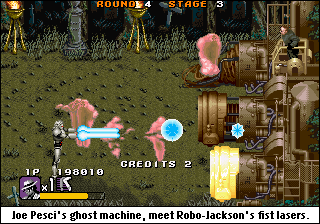 It's the last two boss fights that really get you scratching your head. In the graveyard level Joe Pesci has somehow commandeered or created a machine that spawns ghosts out of three separate tubes. The entire fight he's shouting what sounds like "BOOM! Move it!" but I can't really be sure. Robo-Michael Jackson has to destroy each tube individually while also lasering the ghosts that attack him. When the machine explodes, the entire catwalk Joe Pesci is standing on levitates with jet engines or something, and flies away. What just happened?
It's the last two boss fights that really get you scratching your head. In the graveyard level Joe Pesci has somehow commandeered or created a machine that spawns ghosts out of three separate tubes. The entire fight he's shouting what sounds like "BOOM! Move it!" but I can't really be sure. Robo-Michael Jackson has to destroy each tube individually while also lasering the ghosts that attack him. When the machine explodes, the entire catwalk Joe Pesci is standing on levitates with jet engines or something, and flies away. What just happened?
 The story is simple enough: you are Mario, a plumber from somewhere not here, and the Princess of the Mushroom Kingdom has been kidnapped by a giant evil turtle bent on forcing her to marry him. All previous attempts to rescue her by her servants have resulted in their also being captured, so it is up to you to go save her from, presumably, interspecies rape.
The story is simple enough: you are Mario, a plumber from somewhere not here, and the Princess of the Mushroom Kingdom has been kidnapped by a giant evil turtle bent on forcing her to marry him. All previous attempts to rescue her by her servants have resulted in their also being captured, so it is up to you to go save her from, presumably, interspecies rape.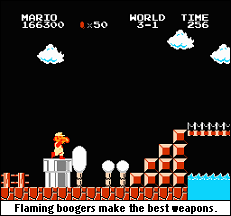 The contents of these boxes are puzzling to say the least. Inside you will find gold coins, which are the standard Mushroomian currency (and collecting 100 of which give you an extra life without ever visiting a banker), smaller, edible mushrooms, sentient stars that make you completely invincible to everything but gravity, and glowing flowers that, when touched, ignite Mario's snot into flaming bouncing balls of doom.
The contents of these boxes are puzzling to say the least. Inside you will find gold coins, which are the standard Mushroomian currency (and collecting 100 of which give you an extra life without ever visiting a banker), smaller, edible mushrooms, sentient stars that make you completely invincible to everything but gravity, and glowing flowers that, when touched, ignite Mario's snot into flaming bouncing balls of doom. In any case, each level consists of running from one little castle or outpost to the next one, lowering the enemy Koopas' flag, raising a new flag that is a little reminiscent to the
In any case, each level consists of running from one little castle or outpost to the next one, lowering the enemy Koopas' flag, raising a new flag that is a little reminiscent to the  All this is great and exciting, but then you come to a place where your enthusiasm dies with your soul and you begin to wish this game had some sort of warp zone: I am speaking, of course, about the dreaded water levels.
All this is great and exciting, but then you come to a place where your enthusiasm dies with your soul and you begin to wish this game had some sort of warp zone: I am speaking, of course, about the dreaded water levels. The game starts out easily enough, though by the eighth and final world, the difficulty has ramped up quite a bit. As you can see at right, the enemies become more populous and cannons start firing at your face and it's all just quite the mess. There are usually safe areas to stand, but even then, good luck. The game is a challenge for sure, though it becomes far easier with practice and is never unreasonably hard by any degree.
The game starts out easily enough, though by the eighth and final world, the difficulty has ramped up quite a bit. As you can see at right, the enemies become more populous and cannons start firing at your face and it's all just quite the mess. There are usually safe areas to stand, but even then, good luck. The game is a challenge for sure, though it becomes far easier with practice and is never unreasonably hard by any degree. Of course, after every castle and supposed fight with Bowser, the King Koopa, you only find a little mushroom man telling you that the Princess is in another castle. By the time you get to the real Bowser, he's spitting fire and throwing hammers like it's his job. All you have to do is run by him to win, but that can be easier said than done. Unless, that is, you're giant Mario. Then you can just run into and through him. You'll shrink, but he'll die. Hey, it works.
Of course, after every castle and supposed fight with Bowser, the King Koopa, you only find a little mushroom man telling you that the Princess is in another castle. By the time you get to the real Bowser, he's spitting fire and throwing hammers like it's his job. All you have to do is run by him to win, but that can be easier said than done. Unless, that is, you're giant Mario. Then you can just run into and through him. You'll shrink, but he'll die. Hey, it works.